
by Blog Staff | Jul 29, 2011 | Industry Intel, Threat Lab












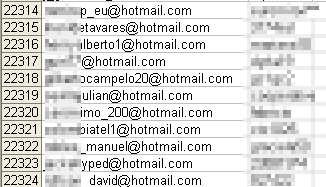 Late Monday, after news about the death of troubled pop singer Amy Winehouse had been circling the globe for a little more than 48 hours, we saw the first malware appear that used the singer’s name as a social engineering trick to entice victims to run the malicious file. Abusing celebrity names, news, or even deaths isn’t a new (or even particularly interesting) social engineering tactic, but there was one unique aspect to this particular malware’s behavior that raised some eyebrows around here: It appears that Brazilian phisher-Trojan writers seem to be working more closely with their Chinese counterparts, using servers in China as dead drops for their stolen goods.
Late Monday, after news about the death of troubled pop singer Amy Winehouse had been circling the globe for a little more than 48 hours, we saw the first malware appear that used the singer’s name as a social engineering trick to entice victims to run the malicious file. Abusing celebrity names, news, or even deaths isn’t a new (or even particularly interesting) social engineering tactic, but there was one unique aspect to this particular malware’s behavior that raised some eyebrows around here: It appears that Brazilian phisher-Trojan writers seem to be working more closely with their Chinese counterparts, using servers in China as dead drops for their stolen goods.
The widely-reported case of the malware campaign continues to distribute new, randomized files via a download link managed through a dynamic DNS service, more than a week on. The file’s name, in Portugese, (“103684policia-inglesa-divulga-fotos-do-corpo-da-cantora-amy-winehouse-WVA.exe“) translates roughly to English police divulge photos of singer Amy Winehouse’s corpse, but victims who open this file are only going to see their computer become compromised.
The malware modifies the Hosts file in Windows to redirect traffic from 78 different Web sites — the vast majority of which are Brazilian banks and finance sites such as e-gold, with the rest being American Express, and Microsoft‘s Brazilian and US domains for Hotmail, Live, and MSN — to one of 9 IP addresses, almost all of which point to servers hosted in Chinese networks. One oddball outlier IP address in the modified Hosts file list points to an IP address belonging to the network operated by the Ford Motor Company, but that IP address was not allocated to an operational server when I did some tests.
(more…)

by Blog Staff | Jul 20, 2011 | Industry Intel, Threat Lab












 The criminals who push rogues at the world don’t really care about the reputations of the ISPs or Web hosting services they abuse. They leap from free service to free service until they’ve thoroughly worn out their welcome and, in some cases, destroyed the reputation of the service they abused. But they have behaved in one predictable way over the years: They’re stingy, and won’t pay for anything unless it’s absolutely necessary, despite the fact that they’re raking in cash by the boatload.
The criminals who push rogues at the world don’t really care about the reputations of the ISPs or Web hosting services they abuse. They leap from free service to free service until they’ve thoroughly worn out their welcome and, in some cases, destroyed the reputation of the service they abused. But they have behaved in one predictable way over the years: They’re stingy, and won’t pay for anything unless it’s absolutely necessary, despite the fact that they’re raking in cash by the boatload.
But that seemed to change this week when we saw a number of Web sites pop up on the radar. The sites employ the now well-worn scam of pretending to be some sort of video streaming service. In this case, they pretended to be a porn site, but the most surprising part was not what was hosted, but where: Amazon’s Cloudfront hosting service ended up, temporarily for a few hours, serving up malicious Web pages. Amazingly, it seems they actually paid for hosting instead of just stealing it.
Amazon shut the sites down quickly, but before they did, we visited one site called xrvid-porno.com. The page isn’t exactly family friendly, but the gist of the scam is that that page eventually redirected the browser to a server inside of Amazon’s cloud hosting service, and that’s where the trouble began.
(more…)

by Blog Staff | Jul 19, 2011 | Industry Intel, Threat Lab
By Marco Giuliani
 Among the most infamous kernel mode rootkits in the wild, most of them have had a slowdown in their development cycle – TDL rootkit, MBR rootkit, Rustock are just some examples. The same doesn’t apply for the ZeroAccess rootkit. The team behind it is working quite hard, which we know for a fact because I’ve seen it.
Among the most infamous kernel mode rootkits in the wild, most of them have had a slowdown in their development cycle – TDL rootkit, MBR rootkit, Rustock are just some examples. The same doesn’t apply for the ZeroAccess rootkit. The team behind it is working quite hard, which we know for a fact because I’ve seen it.
We already talked about this rootkit and its evolutions in several blog posts, along with a white paper that documents more in depth all the technical features of the malware. The last major update released by the team behind ZeroAccess dates back a couple of weeks; That update implemented a strong self-defense routine able to kill security software programs that try to get access to its code, blocking the security software from running by manipulating access control list, or ACL, settings.
Last week ZeroAccess received another update, and again it’s a major one. The rootkit shifted from a hidden encrypted file used as an NTFS filesystem volume to a more comfortable hidden directory created inside the Windows folder, where the rootkit still stores its configuration data and other malware in an encrypted form.
(more…)

by Blog Staff | Jul 8, 2011 | Industry Intel, Threat Lab












 Last week, threat researcher and malware reverse-engineer Marco Giuliani wrote up a fairly technical description of a bootkit — a rootkit that infects the master boot record of the hard drive, making it very difficult to remove — called Popureb. Marco’s report made it clear that the bootkit does not require Windows users to format the hard drive and reinstall Windows from scratch, as Microsoft had initially claimed was required for victims of this drive-by infection.
Last week, threat researcher and malware reverse-engineer Marco Giuliani wrote up a fairly technical description of a bootkit — a rootkit that infects the master boot record of the hard drive, making it very difficult to remove — called Popureb. Marco’s report made it clear that the bootkit does not require Windows users to format the hard drive and reinstall Windows from scratch, as Microsoft had initially claimed was required for victims of this drive-by infection.
Andrea Allevi, one of our developers who works under Marco’s direction, subsequently wrote a tool that can remove the bootkit from an infected computer, which we’re releasing today to the public. We don’t offer technical support for the tool, but it’s fairly straightforward to use: Just launch it on a system infected with Popureb.E, using an account with Administrator privileges. It will ask your permission to clean the infected MBR, and once you say ‘yes’ it’ll do the rest. You’re welcome!

by Blog Staff | Jul 8, 2011 | Industry Intel, Threat Lab
By Marco Giuliani












 The latest generation of a rapidly evolving family of kernel-mode rootkits called, variously, ZeroAccess or Max++, seems to get more powerful and effective with each new variant. The rootkit infects a random system driver, overwriting its code with its own, infected driver, and hijacks the storage driver chain in order to hide its presence on the disk. But its own self-protection mechanism is its most interesting characteristic: It lays a virtual tripwire.
The latest generation of a rapidly evolving family of kernel-mode rootkits called, variously, ZeroAccess or Max++, seems to get more powerful and effective with each new variant. The rootkit infects a random system driver, overwriting its code with its own, infected driver, and hijacks the storage driver chain in order to hide its presence on the disk. But its own self-protection mechanism is its most interesting characteristic: It lays a virtual tripwire.
I’ve written about this rootkit in a few recent blog posts and in a white paper. On an infected computer, this new driver sets up a device called Devicesvchost.exe, and stores a fake PE file called svchost.exe – get it? The path is Devicesvchost.exesvchost.exe. The driver then attaches itself to the disk device stack. The driver creates a new system process, called svchost.exe, pointing to the path: \GlobalrootDevicesvchost.exesvchost.exe. This fake process serves as a kind of trap, specifically looking for the types of file operations performed by security software.
When a typical security scanner tries to analyze the rootkit-created svchost.exe file, the rootkit queues an initialized APC into the scanner’s own process, then calls the ExitProcess() function — essentially forcing the scanner to kill itself. The rootkit’s effectiveness, however, is hindered by a weakness in the way the rootkit filtered disk I/O. As it turned out, we can easily bypass the filtering technique and get to the masked data. We’ve also reversed the code the rootkit uses to generate domain names it will contact for command-and-control, and have provided a list of the domains it will use in the months of July, 2011 and August, 2011 so network managers can protect themselves proactively.
(more…)

by Blog Staff | Jul 6, 2011 | Industry Intel, Threat Lab












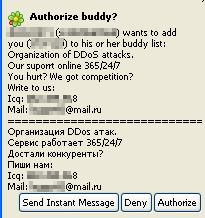 The other morning, I walked into the office to find a slew of instant messaging buddy requests from total strangers. This isn’t unexpected: I frequently get buddy requests on IM accounts I maintain for research purposes that contain malicious URLs and other useful research data. But this was one request I wasn’t expecting.
The other morning, I walked into the office to find a slew of instant messaging buddy requests from total strangers. This isn’t unexpected: I frequently get buddy requests on IM accounts I maintain for research purposes that contain malicious URLs and other useful research data. But this was one request I wasn’t expecting.
The inquiry, written in both English and Russian, was simply an advertisement for “Organization of DDOS attacks” from an ICQ account that has not been used since the friend request came in. The somewhat perplexing offer claims the service offers “support online 24/7/365” (finally, a DDOS service that works weekends and holidays, unlike those slacker DDOSers who only work during banker’s hours) and asks “You hurt? We got competition?”
Who’s this we you’re referring to, mister criminal mastermind?
The solicitation for business included a different ICQ user ID number than the one used to send the buddy request, as well as an email address. I’ve seen some strange solicitations for various kinds of business delivered this way, but never one so brazen over an ostensibly illegal (both in Russia and elsewhere) service.
It’s too bad I can’t tell the guy to just go DDOS himself, but the accounts used in the ad have all been shut down.

by Blog Staff | Jun 30, 2011 | Industry Intel, Threat Lab
By Marco Giuliani












 Last Wednesday, Microsoft published a blog post detailing a significant update to a piece of malware named Popureb. The malware adds code to the Master Boot Record, or MBR, a region of the hard disk that’s read by the PC during bootup, long before the operating system has had a chance to get started. Researchers sometimes refer to these kinds of malware as bootkits, or a rootkit which loads at such a low level during the boot process that it is invisible to the operating system, and therefore very difficult to remove.
Last Wednesday, Microsoft published a blog post detailing a significant update to a piece of malware named Popureb. The malware adds code to the Master Boot Record, or MBR, a region of the hard disk that’s read by the PC during bootup, long before the operating system has had a chance to get started. Researchers sometimes refer to these kinds of malware as bootkits, or a rootkit which loads at such a low level during the boot process that it is invisible to the operating system, and therefore very difficult to remove.
Microsoft researcher Chun Feng detailed some of the new features of Popureb.E, which includes a very low-level hook into the Windows driver responsible for disk writes and reads. When the driver on an infected system detects an attempt to write changes into the MBR — the kinds of changes a repair tool might try to make — it simply changes the command from write to read, effectively neutering any kind of tool running within Windows that might try to fix the infection.
(Update 2011-07-08: We’ve published a free command line tool that can remove Popureb.E from the master boot record of an infected computer.)
Microsoft’s initial cleanup guidance on Popureb.E was pretty drastic, and more than a little scary: Full removal of the bootkit requires a full reinstall of Windows, wiping out anything currently on the hard drive. We don’t think this is the case, and the Microsoft folks seem to have moderated their advice to include some manual fixes using the recovery console.
While the whole concept behind the Trojan is valid and technically powerful, the practical implementation of the malware is not as valid as the idea behind it. What follows is a fairly technical write-up that describes both the problem, and one solution we’ve come up with.
(more…)

by Blog Staff | Jun 24, 2011 | Industry Intel, Threat Lab












 Ah, summer. Beaches, drinks with little umbrellas, 4th of July fireworks, baseball games, reading long cheesy novels in a lounge chair, teleconferencing with colleagues from your hotel room in Aruba. Wait, what?
Ah, summer. Beaches, drinks with little umbrellas, 4th of July fireworks, baseball games, reading long cheesy novels in a lounge chair, teleconferencing with colleagues from your hotel room in Aruba. Wait, what?
Yes, it’s true. It takes serious discipline to travel without schlepping along a laptop, smartphone, digital camera, MP3 player, portable hard drive, SD cards, and a host of support equipment. Well, it does for me, anyway. Along with those devices come pitfalls, from loss to data theft. So, in the spirit of safe summer travel, in advance of the big 4th of July travel weekend, what follows are Webroot’s five tips for summer travelers who can’t go anywhere without bringing along gadgets.
1. Watch where you WiFi
It can be tempting to take advantage of free WiFi access points in airports, hotels, or in cafes, but resist the urge to use those connections to do anything other than browse for a map or train schedule. Unsecured wireless connections — such as the open ones that some businesses provide as a service — can also leave you vulnerable to wireless snooping of your logins, email messages, or instant messages by other travellers or guests. The same can be said for untrusted computers in hotel business centers or cybercafes, which are magnets for data-stealing malware.
If the connection doesn’t ask you to provide a WPA key, assume the connection is not secure, and treat it as such; If you must use a free wireless connection, turn off any programs that automatically connect to the Internet (such as email clients or file-sharing tools) before you hook up. And please don’t use the untrustworthy PC in the hotel lobby to do anything more private than print your boarding pass to get home.
(more…)

by Blog Staff | Jun 21, 2011 | Industry Intel, Threat Lab
By Ian Moyse, EMEA Channel Director












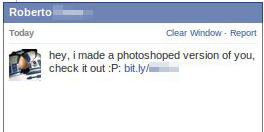 It can seem at times that the only people who like change are Internet attackers. And they don’t just like it—they need it. Technology’s rapid changes give cybercriminals new attack vectors to exploit, and new ways to turn a profit out of someone else’s misfortune.
It can seem at times that the only people who like change are Internet attackers. And they don’t just like it—they need it. Technology’s rapid changes give cybercriminals new attack vectors to exploit, and new ways to turn a profit out of someone else’s misfortune.
Take phishing, for example. The concept is simple: Send an email disguised as a message from a bank, PayPal, or UPS. Wait for the user to click a link in the message, and enter their private details into a phishing site, and presto! The attacker attains financial or personal login details that can be used to commit fraud or theft.
Of course, it was only a matter of time before most people caught on to email scams. Users read again and again not to click on such links. Mail solutions became better at spotting phishing emails and filtering them into a junk email folder. Even free Web mail providers now catch the majority of these attacks.
Once cybercriminals noticed their traditional phishing approaches were returning lower response rates, they rapidly adjusted to new mediums. As a result, a new trend emerged: smishing (social media phishing) became the new trend in cyber attacks.
(more…)

by Blog Staff | Jun 20, 2011 | Industry Intel, Threat Lab
By Stephen Ham and Andrew Brandt












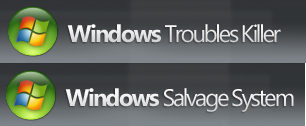 This week’s rogue, once again, mimics a system utility and not merely an antivirus product. Either way, the scam is the same: Convince the victim that their computer is broken, then coerce them to pay for useless snake oil.
This week’s rogue, once again, mimics a system utility and not merely an antivirus product. Either way, the scam is the same: Convince the victim that their computer is broken, then coerce them to pay for useless snake oil.
These rogue system utilities go by the names Windows Troubles Killer or Windows Salvage System; They are, for all intents and purposes, identical programs which have been “skinned” with different names. They actually appear to be a hybrid rogue, carefully blending a customized mix of malarkey and baloney into some sort of shenanigans smoothie. The program claims not only to be able to scan your computer for problems with software settings and other system optimization-sounding stuff, but also to perform some sort of check of your “Computer Safety” and “Network Security.” Oh yes, and there’s an antivirus component too, just to round out the complete package.
All in all, it’s a fairly rudimentary rogue to remove (whether you choose to do it manually or use our software), but it performs some unique system modifications that disable some legitimate security software, turns off some important Windows features, mimics some of Microsoft’s own software, and generally acts as a nuisance while reducing the actual security level of an infected computer. I’ll detail those after the jump.
(more…)

by Blog Staff | Jun 17, 2011 | Industry Intel, Threat Lab












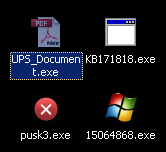 As if we didn’t have enough to deal with this week — after a Microsoft patch Tuesday that brought with it a boatload of security updates for Windows, Office, Silverlight, Visual Studio, and other programs — some enterprising malware distributor is emailing around bogus tracking number malware dressed up in the icon of a PDF document, and that malware is downloading payloads named after the updaters that Windows Update retrieves during an update.
As if we didn’t have enough to deal with this week — after a Microsoft patch Tuesday that brought with it a boatload of security updates for Windows, Office, Silverlight, Visual Studio, and other programs — some enterprising malware distributor is emailing around bogus tracking number malware dressed up in the icon of a PDF document, and that malware is downloading payloads named after the updaters that Windows Update retrieves during an update.
The malware arrived into one of our spam collection points with an attachment named UPS_document.zip. Way to be original there, criminals. Inside the Zip file was an executable downloader named UPS_Document.exe. Upon execution, it retrieves at least three payloads, including a copy of SpyEye (a password stealing Trojan), a tiny agent sending profiling information about the infected system, and a fraudulent “rogue system utility” called (on my XP testbed) Windows XP Restore.
The rogue takes on much of the appearance of a previous Rogue of the Week, named Windows Recovery. In fact, Windows XP Restore looks to be a very slightly modified duplicate of that software. If you’ve been hit with either rogue, there are some cool free tools for you to download that will repair some of the damage; Read on for details.
(more…)

by Blog Staff | Jun 10, 2011 | Industry Intel, Threat Lab












 Most of yesterday, Threat Research Analyst Armando Orozco and I took a closer look at a piece of malware discovered by a university security researcher, Xuxian Jiang of North Carolina State. The malicious code, which the malware creator named Plankton, is embedded into a number of apps that were briefly posted to Google’s Android Market earlier this week, then rapidly pulled down after the researchers informed Google of their initial findings.
Most of yesterday, Threat Research Analyst Armando Orozco and I took a closer look at a piece of malware discovered by a university security researcher, Xuxian Jiang of North Carolina State. The malicious code, which the malware creator named Plankton, is embedded into a number of apps that were briefly posted to Google’s Android Market earlier this week, then rapidly pulled down after the researchers informed Google of their initial findings.
The Plankton code appears in a number of applications that were all focused on the popular game series Angry Birds. Some of the samples we looked at came as Android apps with names like Angry Birds Rio Unlocker v1.0, Angry Birds Multi User v1.00 or Angry Birds Cheater Trainer Helper V2.0.
When executed, the program displays the following text on the screen:
Welcome!
Simply click on the button below to unlock ALL levels in Angry Birds Rio. This will not delete your scores but might change the number of pineapples and bananas you have
None of the programs function as advertised. Instead, the malicious apps install additional code into the Android device into which they’re installed. These additional functions provide remote access and control of the Android device to, presumably, the distributor of the malicious apps, whose identity remains unknown at this time.
(more…)
Page 3 of 6«12345...»Last »

 Late Monday, after news about the death of troubled pop singer Amy Winehouse had been circling the globe for a little more than 48 hours, we saw the first malware appear that used the singer’s name as a social engineering trick to entice victims to run the malicious file. Abusing celebrity names, news, or even deaths isn’t a new (or even particularly interesting) social engineering tactic, but there was one unique aspect to this particular malware’s behavior that raised some eyebrows around here: It appears that Brazilian phisher-Trojan writers seem to be working more closely with their Chinese counterparts, using servers in China as dead drops for their stolen goods.
Late Monday, after news about the death of troubled pop singer Amy Winehouse had been circling the globe for a little more than 48 hours, we saw the first malware appear that used the singer’s name as a social engineering trick to entice victims to run the malicious file. Abusing celebrity names, news, or even deaths isn’t a new (or even particularly interesting) social engineering tactic, but there was one unique aspect to this particular malware’s behavior that raised some eyebrows around here: It appears that Brazilian phisher-Trojan writers seem to be working more closely with their Chinese counterparts, using servers in China as dead drops for their stolen goods.


































































































